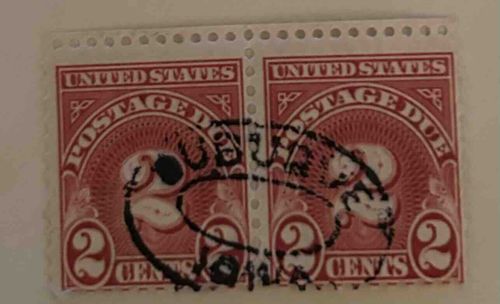
United States 2 Cents Postage Due Stamps (Block of Two)
This item consists of a conjoined block of two United States postage due stamps, each denominated at 2 cents. The color of the stamps is a distinct reddish-brown or carmine, printed on white paper. Each stamp features a design with the words "UNITED STATES" at the top, and "POSTAGE DUE" curved in an arch below, with "2 CENTS" horizontally at the bottom. The numeral '2' is prominently displayed in the bottom-left and bottom-right corners within ornate ovals. The central design element appears to be a stylized '2' against a background of concentric lines or an engine-turned pattern, characteristic of security printing methods often employed in philately. Both stamps are perforated along all four edges, indicating they were separated from a larger sheet. The perforations appear relatively clean and intact. A significant feature is the presence of a postal cancellation mark, in black ink, which largely covers the center and right portions of the left stamp and extends over to a part of the right stamp. This cancellation mark, while obscuring some details, confirms the stamps were used for their intended purpose. The condition shows moderate wear from circulation and handling, typical for used postage stamps. The colors remain relatively vibrant, suggesting good preservation despite the cancellation. There are no obvious tears or major creases visible, though a more detailed inspection would be required to confirm this. The overall aesthetic is consistent with late 19th to early 20th-century U.S. postage due issues.
AI-Generated Appraisal Disclaimer
Estimated Value
$50 - $80
Basic Information
Category
Philatelyst_category_keywords_tags_string_raw_raw_output_type_array_of_strings_item_category_string_item_category_string_item_category_enum_categories_string_item_category_string_item_category_enum_categories_string_item_category_enum_categories_string_item_category_string_item_category_enum_categories_string_string_item_category_philately_item_category_string_item_category_enum_categories_philately_item_category_philately_item_category_philately_item_category_philately
Appraised On
December 24, 2025
Estimated Value
$50 - $80
Item Description
This item consists of a conjoined block of two United States postage due stamps, each denominated at 2 cents. The color of the stamps is a distinct reddish-brown or carmine, printed on white paper. Each stamp features a design with the words "UNITED STATES" at the top, and "POSTAGE DUE" curved in an arch below, with "2 CENTS" horizontally at the bottom. The numeral '2' is prominently displayed in the bottom-left and bottom-right corners within ornate ovals. The central design element appears to be a stylized '2' against a background of concentric lines or an engine-turned pattern, characteristic of security printing methods often employed in philately. Both stamps are perforated along all four edges, indicating they were separated from a larger sheet. The perforations appear relatively clean and intact. A significant feature is the presence of a postal cancellation mark, in black ink, which largely covers the center and right portions of the left stamp and extends over to a part of the right stamp. This cancellation mark, while obscuring some details, confirms the stamps were used for their intended purpose. The condition shows moderate wear from circulation and handling, typical for used postage stamps. The colors remain relatively vibrant, suggesting good preservation despite the cancellation. There are no obvious tears or major creases visible, though a more detailed inspection would be required to confirm this. The overall aesthetic is consistent with late 19th to early 20th-century U.S. postage due issues.
Get Your Items Appraised
Instant estimates of your treasures with AI-powered instant appraisals